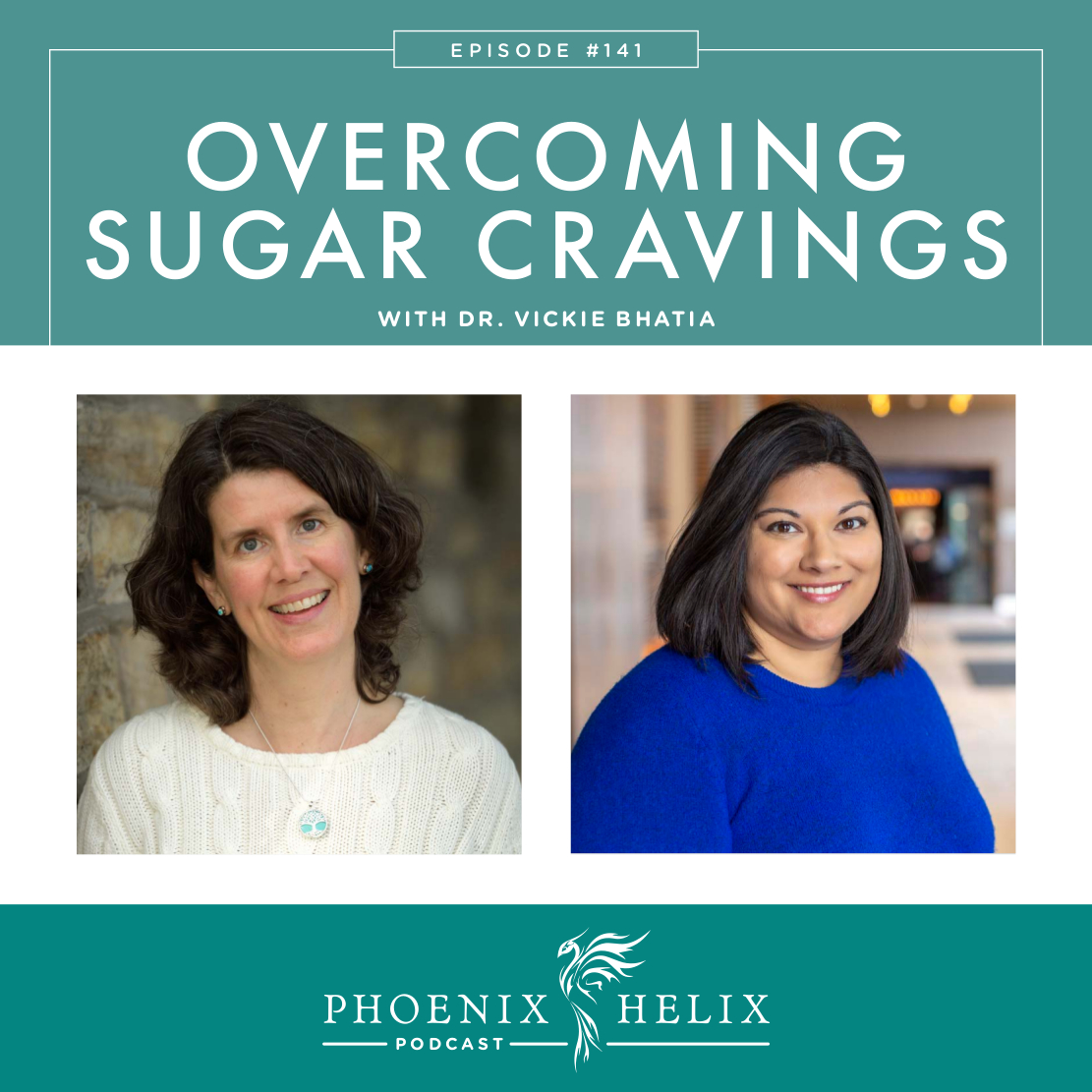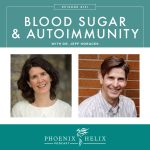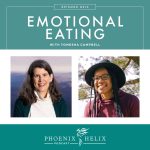Why Are Sugar Cravings So Strong?
While not everyone has a sweet tooth, a lot of us do, and it’s often hard to break the sugar habit. Why is that so true? It turns out there are a lot of forces driving those cravings: emotional, psychological, and even biological. It’s no wonder they’re not easy to resist. In today’s episode, we dive into the details. My guest is holistic psychologist Dr. Vickie Bhatia. We discuss everything from the gut microbiome and brain chemistry, to the emotions surrounding food, to the psychology of habit change. Most importantly, we share practical tips for making empowered food choices, and breaking the sugar craving cycle.
Listen to the Show
- Subscribe to my podcast through your favorite podcast app: iTunes, Stitcher, Google, TuneIn, Spotify, Amazon, etc.
- You can also listen to the episode right here through the player below, and if you subscribe to my newsletter you’ll get notified of future episodes.
Podcast: Play in new window | Download
Show Notes
- Intro (0:00)
- Thank You to Our Podcast Sponsor: Paleo on the Go (1:41)
- A frozen meal delivery service, 100% of their menu is compliant with the elimination phase of the paleo autoimmune protocol (AIP). They have over 5o items, including entrees, side dishes, broth, AIP-friendly bacon, and desserts.
- Use the code PHOENIX for 10% off your first order.
- Meet Vickie (3:08)
- Dr. Vickie Bhatia is a clinical psychologist and Whole30 health coach. She has a holistic treatment philosophy, looking at the whole person: physically, mentally, and emotionally. There’s an emerging awareness in the mental health community that food plays a role in mental health (although this still isn’t taught in most graduate schools).
- Vickie learned this connection personally when she did her first Whole30 in 2015. She discovered that certain foods negatively impacted her mood, concentration, ability to focus, energy levels, and quality of sleep.
- What is the Whole30? (6:37)
- Like the Paleo Autoimmune Protocol (AIP), the Whole30 is a reset diet with an elimination phase and a reintroduction phase. Its goal is to help people learn which foods negatively impact their physical and mental health.
- The Whole30 template is strict paleo (no dairy, no grains, no legumes, no refined oils, no processed foods, no additives, no alcohol). But it also removes all added sugars, even natural ones.
- It differs from the AIP in two ways: (1) That removal of natural sugars (which are allowed in moderation on the AIP). (2) Also, the Whole30 isn’t focused on autoimmunity. So, foods that are eliminated on the AIP because they are potential autoimmune triggers (like eggs, nightshades, nuts, and seeds) are allowed on the Whole30.
- Some people with autoimmune disease combine the AIP + Whole30 together temporarily, to more fully identify which foods are inflammation triggers for them (and sugar might be one of those triggers).
- Note: With both the AIP and the Whole30, the elimination phase isn’t meant to last forever. Reintroductions are an important part of the process. The goal is to learn to communicate with your body, discovering which foods do and don’t work for you. The goal isn’t to eat fewer and fewer foods, but rather to personalize your diet in a way that supports your health, with the greatest diversity of foods possible.
- It’s Human Nature to Crave Sugar (9:08)
- There’s nothing wrong with you as a person if you crave sugar. It’s natural. They’ve done studies with new-born infants, showing that we are born with this preference for sweet.
- Our Brains on Sugar (10:30)
- Our brains are wired for survival, and they emphasize short-term survival over long-term consequences. From an evolutionary perspective, sweet tastes were associated with fruits and starchy vegetables which are a source of energy for the body. They were rare to find in ancestral times, so it makes sense that our brain became wired to encourage their consumption.
- When something sweet hits our taste buds, it activates reward circuitry in our brain. It ties together the hippocampus (which stores memories), the insula (which produces emotions), and the caudate nucleus (which influences reward-seeking behavior). They create a feedback loop where you remember how much you enjoyed that sweet taste, and you are encouraged to eat it again. The problem in modern life is that there’s an endless supply of “sweet” possibilities.
- Sweet foods also release dopamine and seratonin, which are neurotransmitters in the brain. Dopamine is associated with reward and pleasure. Seratonin regulates mood, memory, and social behavior. This creates another feedback loop on a chemical level, also driving us to crave sugar.
- Blood Sugar Balance (12:55)
- Sugar is a quick energy source for the body, and our brains need a constant supply of energy. For that reason, blood sugar balance is monitored closely by the brain, with the goal of keeping it in a healthy range.
- Every time we eat sugar, it raises our blood glucose. Our body releases insulin in response, which moves glucose from the blood into the cells, where it can used as fuel. If our blood sugar dips too low, our body then craves sugar to raise those levels again.
- Ideally, blood sugar regulation is smooth and stable, without strong highs and lows (and the strong cravings that follow). But there are many things that can put us on a blood sugar rollercoaster: lack of sleep, chronic stress, inflammation, and eating lots of sugar (or eating sugar by itself without healthy protein and fats to lower the blood sugar impact).
- Resource: Ep. 131 – Blood Sugar and Autoimmunity.
- Sugar and the Gut Microbiome (14:41)
- The gut microbiome comprises all the microorganisms that live in our gut and are meant to support our health. Our diets have a major impact on the balance of bacteria. Beneficial bacteria help with many functions of the body, including digestion and immune balance. Sugar tends to be the preferred food for pathogenic bacteria (the ones that harm instead of help us). So when we eat a lot of sugar, we increase their numbers, and those pathogenic bacteria inspire more sugar cravings because they want to be fed.
- To look at the bigger picture beyond cravings, gut health and mental health are also inter-connected, with beneficial bacteria supporting mental health, and gut dysbiosis being a contributing factor to mental health disorders.
- Resources:
- Does the Body Treat All Sugars the Same? (16:55)
- There is a difference between added sugars and fruit. Fresh fruit contains additional nutrients, water, and fiber. This slows down the absorption of sugar into our bloodstream, and increases feelings of fullness.
- Artificial sugars are 100-1000 times sweeter than natural sugars. This desensitizes our taste buds, so real food doesn’t taste as good. This is reversible, though – when we stop eating artificial sugars, our capacity for taste returns.
- Natural sugars can also desensitize our taste buds. When we cut back on any type of added sugar in our diet, fruits and vegetables start to taste sweeter and more flavorful.
- While natural sugars (like honey and maple syrup) are healthier than refined, they can still negatively impact the body when we eat too much of them. They can disrupt gut health and immune function, and also increase inflammation, including neuroinflammation.
- Sometimes instead of breaking an unhealthy habit, we try to find a way to keep the habit going in a slightly “healthier” way. So we give up artificial or refined sweeteners, and switch to the same quantity of natural ones. Or we give up added sugars altogether but start binging on fresh and dried fruits. We haven’t overcome the craving – the habit is still there.
- Resource: Where Do Natural Sugars Fit on a Healing Diet?
- Tips for Overcoming Biological Sugar Cravings (20:37)
- Step 1: Are you eating enough overall? When you switch to a healing diet and old foods are removed, many people don’t eat enough of the foods allowed on the new diet. Remember that calories are energy. If we’re not eating enough, our bodies will crave sugar because they’re seeking energy. Resource: The 14 Day Calorie Challenge.
- Step 2: Are you eating enough protein and healthy fats? Both of those stabilize blood sugar and also are satiating, helping us feel more full.
- Step 3: Are you getting enough sleep? When we are sleep-deprived, our bodies will crave sugar – again seeking quick energy. Resource: Ep. 94- Troubleshooting Sleep.
- Step 4: How are you managing your stress? Our bodies crave sugar under stress, because they are trying to make sure we have the resources to overcome the perceived threat. Chronic stress can lead to chronic sugar cravings. Stress also increases cortisol and destabilizes blood sugar. Resource: Ep. 44 – The Art of Stress Management.
- Thank You to Our Podcast Sponsor: ShopAIP (26:05)
- Every product at ShopAIP is free from refined sugar, and they have many products that are free from natural sugars as well. Full ingredient lists are provided on product sales pages.
- ShopAIP is an online store dedicated to the Paleo Autoimmune Protocol. With hundreds of items for the elimination phase of the AIP, and new products labeled by reintroduction category as well. You can find protein bars, sauces and condiments, AIP-friendly spices, cooking and baking ingredients, delicious snacks, non-toxic skincare, and more.
- If you’re a first-time customer, use the code PHOENIX for 10% off your order. Purchase here.
- Emotions and Sugar Cravings (27:22)
- In addition to biology, emotions drive cravings as well. We use food for comfort, reward, celebration, nostalgia, and distraction, to name a few. Then the food itself inspires an emotional response. There’s the temporary boost we get after eating something sweet, often quickly followed by guilt, shame, and activation of the inner critic. Shame is one of the most difficult emotions to feel, and most of us will do anything to avoid it. This can create a vicious cycle of eating more to feel better, feeling ashamed, and eating more again. The inner critic gets louder, which can lead to depression, anxiety, and even suicidal thoughts.
- Tips for Overcoming Emotional Sugar Cravings (31:27)
- Step 1: Learn to identify what is happening in the moment – the thoughts and emotions that are behind the craving. Often they are running in the background of our minds, below our conscious awareness. Mindfulness is the practice of observing our thoughts and emotions without judgment. This simple pause before acting on a craving gives us an opportunity to learn more about ourselves and our patterns.
- Step 2: Consider your options. Once you know what’s behind the craving, you can consider alternative ways to meet your needs. Ask yourself what would be most helpful, not only short-term but long-term as well? Each time you make a choice that’s in line with your values, it builds a positive feedback loop, inspiring emotions like confidence, pride, and motivation to continue to make healthy choices.
- Step 3: Sometimes you’ll make the choice to eat sugar anyway, having decided you’re willing to accept the consequences. This is part of habit change. You become aware of what precedes the craving, and also what happens when you eat sugar. If the consequences are small, no worries. If the consequences are high, that’s information that can help you make a different choice in the future. If you do choose to indulge and your inner critic kicks in, this is another place where you can break the cycle. Replace that inner critic with self-compassion instead. Research shows that a compassionate inner voice is much more effective at helping us achieve our goals than a critical voice.
- Step 4: Be aware that perfectionism can be a hindrance instead of a help when it comes to habit change. All-or-nothing thinking limits our choices and keeps our inner critic activated.
- Step 5: When you’re not under stress, come up with a list of non-food activities that meet your emotional needs in a supportive way. Consider desires for comfort, celebration, reward, nostalgia, and distraction. It’s great to have this list as a reference when you’re under stress and cravings are strong. You can also put together an Emotional Crisis Management Kit that includes things you can use immediately. Choose items that engage your senses, which help to ground us when we’re feeling overwhelmed.
- Step 6: Professional counseling can also be really helpful when learning new coping skills and making life changes.
- Resources:
- 101 Ways to Treat Yourself that Have Nothing to Do with Food.
- Ep. 214 – Emotional Eating.
- Eat Right Now App – A mindful eating app that takes you through these steps when you’re in the middle of a craving.
- Calm App – which teaches mindfulness as a daily practice. This builds the skill and makes it easier to access in the moment.
- Why Is Change So Difficult? (43:06)
- Doing something new requires effort, and it may cause anxiety because it’s the unknown. Our brains don’t like the unfamiliar, so change is seen as a potential threat.
- Loss is also part of the equation – loss of old routines and comforts – not just for us but the people around us.
- Relying on motivation and willpower by themselves rarely works. Motivation comes and goes – it’s inconsistent, especially under pressure. Willpower is easily depleted by things like stress and lack of sleep (the same things that drive sugar cravings). Both are usually gone by evening, which is why so many people eat sugar late at night.
- Tips for Successful Habit Change (45:10)
- Ask yourself why this change is important to you? Internal reasons are more powerful than external ones. External reasons don’t inspire lasting change. How we feel and what we can accomplish are stronger motivations than how we look. Also, make sure it’s your own reason – that you aren’t trying to change based on someone else’s (or society’s) expectation of you.
- Set yourself up for success. Everything we do to support our health (sleep, nutrient density, stress management) also supports our ability to make good decisions.
- In addition to being mindful of your emotions in the moment, also look at your family history. How were emotions expressed vs. repressed? Which were considered acceptable vs. not? Are there certain emotions that are more likely to derail your healthy habits? Explore that root cause more deeply.
- Doing a Whole30 or Sugar Detox can help break the biological cravings.
- Plan for the changes. Think about what will be different for you and the people around you. What routines will be disrupted? What social engagements might need to change? How might people react? Have conversations in advance, and be aware that some people will feel threatened by your habit change. Remember, it’s human nature to fear change, and your healthy habit might activate their own inner critic.
- Also be aware that it doesn’t have to be all-or-nothing. For most people, it’s not about giving up sugar completely, but rather reducing the quantity, and being mindful about when and how you consume it. (For example, celebrations vs. using it as a crutch during stressful moments).
- Resources:
- What Healthy Sugar Consumption Looks Like (53:52)
- The Whole30 program has a concept called Food Freedom. After going through the elimination diet and completing reintroductions, you’ve gained knowledge on how different foods (including sugar) impact your physical and mental health.
- With this knowledge, the goal is to make informed choices going forward, weighing benefits against consequences. Sometimes, you’ll choose to mindfully indulge in sugar and enjoy it without shame. It’s a choice, not a craving. Sugar no longer controls you.
- It can take a while to reach this place, and some people will choose to abstain altogether while they work on the root causes behind their cravings.
- It can also be helpful to identify trigger foods. Not all “treats” are the same – specific foods might impact your emotions and habits differently. For example, Eileen enjoys homemade chocolates without overindulging. But store-bought treats, even paleo brands, quickly lead to addictive patterns for her. She’s aware of this pattern and is careful, usually saving store-bought treats for travel.
- It’s all about getting to know yourself and your needs. Food freedom is unique to each person and evolves over time.
- Resource: Food Freedom Forever.
- Outro (58:27)
- You can keep up with Dr. Vickie Bhatia through her website. For 1:1 therapy, she’s licensed in IL and SC. She can work with people virtually, but you need to live in one of those states. However, twice a year she leads an online coaching group for people doing the Whole30, and that’s open to anyone around the world. She also does Food Freedom groups as well.
- Eileen (your podcast host) is the author of multiple books, written to help people thrive with autoimmune disease. Learn more on the Books Page.
- If you like this podcast, follow or subscribe through your favorite podcast app. You can also subscribe to Eileen’s biweekly newsletter.
- Check out the entire archive of podcast episodes.
You May Also Be Interested In
Spreading the Word
If you like the podcast, please leave a positive review in iTunes. It would mean the world to me, and also helps others find the podcast. Here are some quick instructions using your iPhone:
- If you are already subscribed to my podcast: (1) Click the purple podcast icon. (2) At the bottom of the screen, click Library. (3) At the top of the screen, click Shows. (4) Click the Phoenix Helix podcast image. (5) Scroll down the page, and you’ll see Ratings and Reviews. Scroll down a little bit more and click on Write a Review. This will bring up the review screen. Tap 5 stars (if you love the podcast), and then click in the title box, and it will bring up the keyboard. Enter a title and short review. (6) Click Send in the upper right corner. (7) Thank you! Positive reviews give the podcast a higher search ranking in iTunes, helping people find it and letting them know it’s a quality podcast and worth their time to listen.
- If you haven’t subscribed to my podcast: (1) Click the purple podcast icon. (2) In the lower right corner, click the magnifying class. (3) Type Phoenix Helix in the search box. (4) Click the podcast cover in the Show list. (5) If you’d like to subscribe, click the + sign at the top of the screen. (6) To write a review, scroll down the page, and you’ll see Ratings and Reviews. Scroll down a little bit more and click on Write a Review. This will bring up the review screen. Tap 5 stars (if you love the podcast), and then click in the title box, and it will bring up the keyboard. Enter a title and short review. (7) Click Send in the upper right corner. (8) Thank you! Positive reviews give the podcast a higher search ranking in iTunes, helping people find it and letting them know it’s a quality podcast and worth their time to listen.








